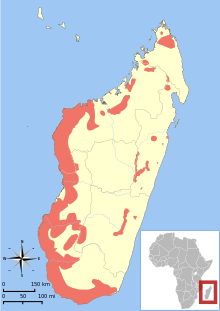| Mouse lemurs | |
|---|---|

| |
| Pygmy mouse lemur (M. myoxinus) | |
| Scientific classification | |
| Domain: | Eukaryota |
| Kingdom: | Animalia |
| Phylum: | Chordata |
| Class: | Mammalia |
| Order: | Primates |
| Suborder: | Strepsirrhini |
| Family: | Cheirogaleidae |
| Genus: | Microcebus É. Geoffroy, 1834[1] |
| Type species | |
| Lemur pusillus É. Geoffroy, 1795
| |
| Diversity | |
| About 25 species | |

| |
| Combined distribution of Microcebus[3] | |
| Synonyms[1][4] | |
| |
The mouse lemurs are nocturnal lemurs of the genus Microcebus. Like all lemurs, mouse lemurs are native to Madagascar.[4]
Mouse lemurs have a combined head, body and tail length of 20–30 centimetres (7.9–11.8 in) and weigh 30–65 grams (1.1–2.3 oz),[5] making them the smallest primates[6] (the smallest species being Madame Berthe's mouse lemur); however, their weight fluctuates in response to daylight duration.[7] Lemurs and mouse lemurs were announced by the IUCN as the most endangered of all vertebrates. There were two known mouse lemur species in 1992; by 2016, there were 24.[8] It was estimated that the 24 mouse lemur species evolved from a common ancestor 18–11 million years ago.[9]
Mouse lemurs are omnivorous; their diets are diverse and include insect secretions, arthropods, small vertebrates, gum, fruit, flowers, nectar, and also leaves and buds depending on the season.[10]
Mouse lemurs are considered cryptic species—with very little morphological differences between the various species, but with high genetic diversity. Recent evidence points to differences in their mating calls, which are very diverse. Since mouse lemurs are nocturnal, they might not have evolved to look different, but have evolved various auditory and vocal systems.[citation needed]
Mouse lemur brains can weigh less than 2 grams (0.071 oz) while their testes can weigh 2.5 grams (0.088 oz).[11]
As written in Genetics, mouse lemurs help to provide a more extensive understanding of the biology, behavior, and health of primates. Mouse lemurs are categorized as prosimian primates. They are among the smallest and most rapidly developing primates and are becoming more abundant in Madagascar and around the world. These tiny creatures are helping to prove valuable information about the biology and evolution of primates through the analysis of their phenotypes and mutations, especially as a model organism for human medical research.[12]
- ^ a b McKenna, MC; Bell, SK (1997). Classification of Mammals: Above the Species Level. Columbia University Press. p. 335. ISBN 978-0-231-11013-6.
- ^ "Checklist of CITES Species". CITES. UNEP-WCMC. Retrieved 18 March 2015.
- ^ "IUCN 2014". IUCN Red List of Threatened Species. Version 2014.3. International Union for Conservation of Nature. 2012. Retrieved 12 March 2015.
- ^ a b Groves, C. P. (2005). "Microcebus". In Wilson, D. E.; Reeder, D. M. (eds.). Mammal Species of the World: A Taxonomic and Geographic Reference (3rd ed.). Baltimore: Johns Hopkins University Press. ISBN 0-801-88221-4. OCLC 62265494.
- ^ Schwitzer, C; Mittermeier, R. A.; Louis Jr., E. E.; Richardson, M. C. (2013). "Family Cheirogaleidae: Mouse, giant mouse, dwarf and fork-marked lemurs". In Mittermeier, Russell A.; Rylands, Anthony B.; Wilson, Don E. (eds.). Handbook of the Mammals of the World. Volume 3. Primates. Barcelona: Lynx Edicions. p. 30. ISBN 978-84-96553-89-7.
- ^ "Primate Factsheets: Mouse lemur (Microcebus) Taxonomy, Morphology, & Ecology". wisc.edu.
- ^ Andrès, M; Gachot-Neveu, H; Perret, M (2001). "Genetic determination of paternity in captive grey mouse lemurs: pre-copulatory sexual competition rather than sperm competition in a nocturnal prosimian?". Behaviour. 138 (8): 1047–63. doi:10.1163/156853901753286560.
- ^ "Yoder Lab – Research". duke.edu.
- ^ Horvath, Julie E.; Weisrock, David W.; Embry, Stephanie L.; Fiorentino, Isabella; Balhoff, James P.; Kappeler, Peter; Wray, Gregory A.; Willard, Huntington F.; Yoder, Anne D. (2008). "Development and application of a phylogenomic toolkit: Resolving the evolutionary history of Madagascar's lemurs". Genome Research. 18 (3): 489–499. doi:10.1101/gr.7265208. PMC 2259113. PMID 18245770.
- ^ Schwitzer, C; Mittermeier, R. A.; Louis Jr., E. E.; Richardson, M. C. (2013). "Family Cheirogaleidae: Mouse, giant mouse, dwarf and fork-marked lemurs". In Mittermeier, Russell A.; Rylands, Anthony B.; Wilson, Don E. (eds.). Handbook of the Mammals of the World. Volume 3. Primates. Barcelona: Lynx Edicions. p. 42. ISBN 978-84-96553-89-7.
- ^ Montgomery, S. H.; Capellini, I.; Venditti, C.; Barton, R. A.; Mundy, N. I. (2011). "Adaptive Evolution of Four Microcephaly Genes and the Evolution of Brain Size in Anthropoid Primates". Molecular Biology and Evolution. 28: 625–638. doi:10.1093/molbev/msq237. PMID 20961963.
- ^ Ezran, Camille; Karanewsky, Caitlin J.; Pendleton, Joseph L.; Sholtz, Alex; Kransnow, Maya R.; Willick, Jason; Razafindrakoto, Andriamahery; Zohdy, Sarah; Albertelli, Megan A. (June 2017). "The Mouse Lemur, a Genetic Model Organism for Primate Biology, Behavior, and Health". Genetics. 206 (2). Mark A. Krasnow also contributed as a writer: 651–664. doi:10.1534/genetics.116.199448. PMC 5499178. PMID 28592502.